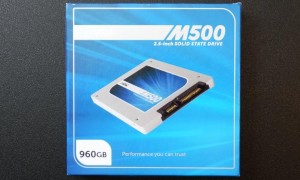CRUCIAL M500 960GB SSD COMPONENTS
The M500 is only 7mm thick and suited for ultra use. A bracket ships in the exterior packaging to make this suitable for 9mm storage use.

 The M500 itself is of an aluminum two piece shell and secured on the bottom by four screws. Although not shown in these photos, one finds the Marvell controller covered with a thermal pad, when opened, which provides for heat dissipation from the controller to the exterior casing. Security tape covers one of the screws which will void your warranty if damaged.
The M500 itself is of an aluminum two piece shell and secured on the bottom by four screws. Although not shown in these photos, one finds the Marvell controller covered with a thermal pad, when opened, which provides for heat dissipation from the controller to the exterior casing. Security tape covers one of the screws which will void your warranty if damaged.
The printed circuit board (PCB) contains a Marvell SS9187 controller, as well as 8 modules of NAND flash memory and a DRAM cache module on each side of the PCB. The memory is Micron 20nm MLC (MT29F512G08CKCABH7) with each being a capacity 0f 64GB. The cache is Micron 1GB of DDR3 SDRAM cache (2 x MT41K256M16HA-125) If you ever want to decipher a Micron FBGA product code as we did with the cache and memory here, the decoding key can be found at the Micron Website.
If you take a close look at the top right of the PCB front, you will notice what only can be described as a community of capacitors above the cache and to the right of the memory. These capacitors ensure that the SSD is powered long enough to complete the writing and storage of all data if a power failure were to occur. For the most part, this is unheard of in consumer SSDs. Its an area where Crucial have cut costs (if they wanted to) as M500 popularity is inevitable and would have been even without the ‘added touch’.
As if power loss data protection weren’t enough, Crucial included another unique feature called ‘Adaptive Thermal Protection’, again one previously reserved for enterprise class SSDs. Simply, if the M500 reaches a temperature of 65DegC (150DegF), the SSD works with the host to adjust the NAND workload and power consumption to decrease the temperature. Technically, it throttles the SSD until the temperature is brought down to an acceptable level.
A quick look at both the M500 mSATA and M.2 NGFF form factors clearly shows capacitors present for power loss data protection as well. Although we haven’t mentioned it yet, the M500 also has hardware based encryption technology (TCG Opal 2.0 + IEEE 1667) designed to maintain data security in the event of device theft or loss.
 The SSD Review The Worlds Dedicated SSD Education and Review Resource |
The SSD Review The Worlds Dedicated SSD Education and Review Resource | 
They are in Stock and 570.00 on Amazon. No forum link for this drive
Crucial M500 960GB SATA
2.5-Inch 7mm (with 9.5mm adapter) Internal Solid State Drive
CT960M500SSD1
20nm nand and 25 nm nand is very hard to find which I find puzzling because Crucial makes their own nand. Hence this 960gb Crucial is not available at its 599.00 price anymore. Its out of stock at most vendors and as soon as its in stock its sold out in 5 minutes.
This is one heck of a drive! I want one.
Hey David my old friend. Good to see you jump in as always…been a few years hasnt it…
Nice performance for the price! Not so high end but can’t complain.
The performanc on this drive is rather unique. On one hand we can see where the Samsung and OCZ better it in areas such as IOPS and incompressible data performance but, on the other hand, it seemed to stand up to both in such things as the AS SSD and Anvil Total Scores and blew both away in Vantage Total Point Scoring.
Right as always Les. Well i consider the low 4k read the most important factor for ssd perf because it’s the only value that you can’t improve by RAID. Actually you might decrease it a bit. Drives with strong perf should be >35mb/s in 4k like m5pro or 840pro. I may be wrong though and feel free to correct me.
The drive has support for both TCG Opal 2.0 and IEEE 1667 specifications. Having the
Opal 2.0 support means that you can utilize third-party encryption to
make the system more secure. It also provides full
compatibility with BitLocker encryption built into Windows 8. This is the
first SSD with explicit support for this feature. It also support’s Device Sleep (DEVSLP), a new standard which consumes less power between state changes, enabling fast exit latency and a more efficient energy profile. I have been reading the SSD review for many months now and really enjoy the articles and respect the attention to detail and repetition utilized during the testing procedures. Excellent work gentlemen.
Thanks Mark!!! Always looking for new site contributors and your background is solid!
Is it possible to show Host Read/Write-values with CDI?